From NB Archives: Karbi Ramayana II- The Surpanakha Episode and other stories
Total Views |
According to some scholars like Prema Kant Mahanta, the Surpanakha episode is described in Karbi Ramayana but it differs from the original one as narrated by Sage Valmiki. Here, Ravana’s sister is ‘Durpanakha’. She goes to ‘Narajon Hills’ where Sri Ram, Sita and Lakshman are camping during their exile. After locating the camp, she assumes the form of a beautiful damsel and tries to befriend Sita and expresses her desire to have Lakshman as her spouse. Then she goes to Lanka and tells Ravana that though Ram and Lakshman are brothers they are not on good terms with each other and instead they used to fight with each other at a place under a banyan tree surrounded by rock walls.
Meanwhile, Sita briefs Lakshman about the beauty of Durpanakha and insists that he should marry her. The proposal is rejected by Lakshman inviting Sita’s anger. She accuses Lakshman of harboring ill intention of marrying her after Ram’s death and threatens him. Lakshman gives in and agrees to her proposal. When Durpanakha enters his bedroom, he cuts her nose with a knife. She flies back to Lanka writhing in pain.
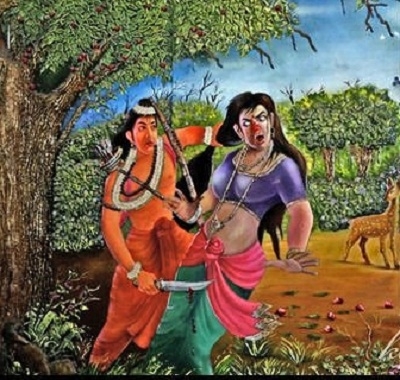
This episode finds mention in Sant Eknath’s “Bhavarth Ramayana” with some variations such as on insistence of Durpanakha Sri Rama writes on her back his ‘consent’ for her marriage with Lakshman. She can’t read what was written. Ram knowing that this beautiful damsel is a Rakshasi, instructs Lakshman to cut her nose and ears but avoid killing her as she would be instrumental in elimination of the Rakshasas including Ravana in future.
Next day she assumes the form of a beautiful deer and begins to graze near the Ashram of Ram and Lakshman. Sita sees this deer and asks Ram to bring it to her either alive or dead for skin and meat. Ram could kill the deer only after crossing 12 hills. At this time Ravana gives a call to Lakshman for help in Ram’s voice. Sita exhorts Lakshman to proceed for Ram’s help and rescue. Lakshman draws four incantatory lines in front of the huts and asks Sita not to cross them.
Lakshman leaves for the rescue of Ram, and reaches Malam Hill to find Ram busy in dressing the deer and drying the meat. Ravana appears before Sita in disguise with a violin and pretends to be extremely hungry and thirsty. Out of compassion Sita crosses the lines and at that moment Ravana appears in his original form and drags Sita to his chariot and flees to Lanka. Jatayu tries to stop Ravana, but the latter kills him with his sword. Karbi Ramayana says, Ram and Lakshman also saw Sita being taken away in a flying chariot. Ram aims his arrow at the chariot but is stopped by Sita.
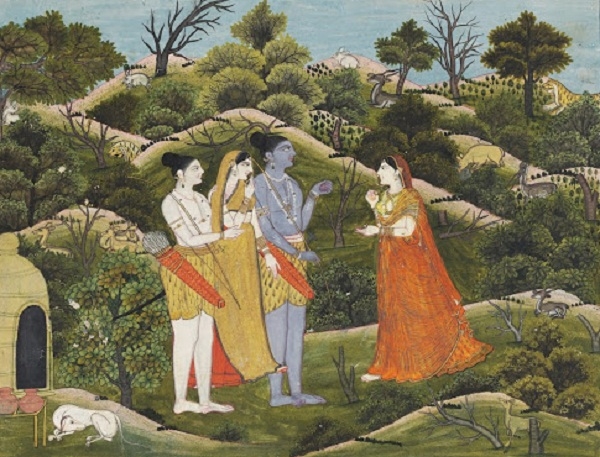
Holding Lakshman responsible for the abduction of Sita, Ram wants to kill him. Lakshman expresses his last desire to have one meal together with Ram. Ram concedes to his last wish and tries to light fire with one wood but could not succeed. Then Lakshman advises him to use two more pieces. Then only the fire catches up. Lakshman interprets this as a good omen and says that Sita would join them soon.
After they had meals together both the brothers set for Panchvati. On the way they find Jatayu lying in a pool of blood. The ‘bird-man’ reveals to them about SIta being abducted by the mighty Ravana before breathing his last. Ram performs his last rites there and moves further south.
They convene a meeting of all the animals of the forest to seek their help in locating and rescuing Sita. Accordingly all the monkeys including their king and Hanuman attend. Hanuman offers his services for going to Lanka and locating Sita. The party marches ahead and meets Bali and ‘Hokuri’ (Sugreev?) at Zeero. Further they reach the seashore and start constructing a bridge with rocks, logs etc. The subjects of Lanka are frightened with the news of construction of the bridge by the invading army and Bibhishana advises Ravana to respectfully handover Sita to Ram to avoid further bloodshed and losses. But he gets snubbed by his elder brother and the King of Rakshasas.
Soon, Hanuman enters Lanka and with the help of Bibhishana locates Sita, talks to her, consoles her by giving the ring of Sri Ram, meets Ravana, asks him to surrender to Ram by handing over Sita to him. Bibhishana switches over to Rama’s party, seeks his protection against Ravana and reveals the secret of Ravana’s death to Ram and Lakshman. Accordingly, Ravana’s life is secretly kept in the form of a humble bee in a hole of a pillar in his bedroom where it is most difficult to reach.
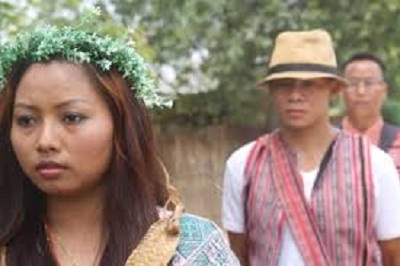
The battle between Ram and Ravana ensues and Ravana’s sharp arrows pierce the chest of Lakshman. So, Hanuman goes to ‘Hoo-Ha-Ha’ hills in search of medicine and he has to return before the sun rises. As the dawn approached, Hanuman snatches the Sun and puts it under his armpit and gets back to the battlefield with an entire hill on his palm. On the way he was forced to land down by Bharat and Shatrughna as he was passing over Ayodhya. (It is here only the reference to Bharat and Shatrughna comes in Karbi Ramayana). Hanuman kills both of them and resumes his journey to the battleground. As he reaches, Ram identifies the medicinal herb.
Ravana’s mother is called for administering the medicine. She tries to kill Lakshman by pushing the arrow further. But Hanuman sees this and dashes her aside. He himself pulls out the arrow and sucks the poison and throws it on the ground. This poison is then consumed by snakes, spiders, and Singi fish and Singra fish. Lakshman is thus cured.
The Mahiravana story is also found in ‘Sabin Alun’ with some differences. One day, Mahiravana, the brother of Ravana who dwells in the nether region, comes to earth in the guise of Bibhishana and abducts Ram and Lakshman to the nether (Patala) region and tries to kill them. However, Hanuman comes to know about the kidnapping of the two brothers and rushes for their rescue. He comes across the sea and contemplates how to cross it. Meanwhile, the daughter of the Sea God appears in the form of a crocodile as she wants to swallow the teardrops falling from Hanuman’s eyes. Hanuman requests her to take him to Patala. On reaching there he assumes a form of a crow and finds Ram and Lakshman; kills Mahiravana and rescues them.
It is again Hanuman who sneaks into Ravana’s bedroom and steals the arrow that would kill the demon king. Ram uses that arrow to eliminate his enemy. Following the victory over Ravana, Ram, Lakshman and Sita return to the Narajon Hills. Sita performs the fire test to prove her chastity and purity to be accepted by Ram which he does; and they all return to Ayodhya.
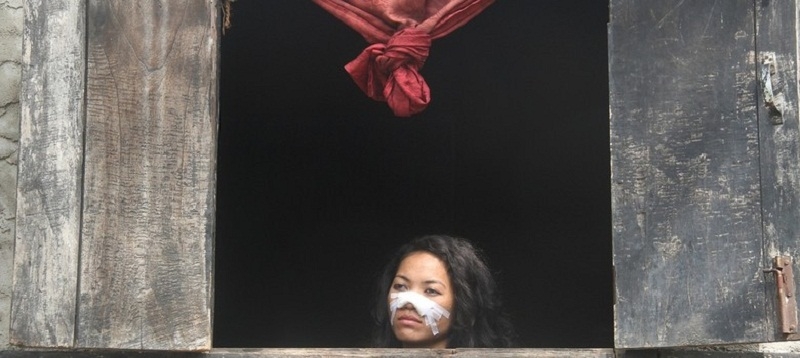
One day Sita expresses her desire to spend some time in the jungle. So, Ram and Lakshman take her to a solitary deep forest and leave her alone there. During her exile, Sita delivers a male child and names him Lav. Hanuman comes to the Jungle to serve Sita for some time. One day, Sita keeps her child in the cradle and goes to fetch water, and asks Hanuman to keep a watch. Hanuman, however, gets asleep for some time and as he wakes up he finds the child missing. He then without wasting time, sculptures a similar child from the rock and placing him in the cradle flees away.
On her arrival, Sita is surprised to see the second child and adopts him as her second son and names him Kush. Sage Valmiki teaches both the children all that are needed for them. Thus Lava and Kush are born and brought up.
Here at Ayodhya Ram performs the Ashwamedha Yagya and the sacrificial horse is let loose. When it reaches Valmiki’s Ashram, Lava and Kush confine the horse and a fierce battle ensues between Ram-Lakshman and the two children. Lava and Kush defeat them, and bring their heads as souvenirs. Sita, after seeing this, weeps profusely. Later the heads are rejoined to their bodies and thus they are brought back to life.
After some time Sita goes to the Zeero Hills and requests Mother Basumati (Earth) to give her way to Patala. Accordingly, the hills break into two and Sita disappears into the cleavage and Ram and Lakshman could not save her. Unable to bear her separation they both end their lives.
This is broadly the story as presented in the Karbi Ramayana.
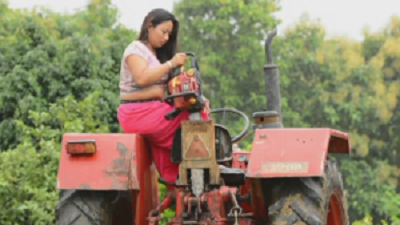
Film on Sabin Alun: Noted Assamese film director Altaf Mazid had made a film on Sabin Alun which was presented at the Mumbai International Film Festival in 2016 titled “Broken Song”. Mazid, who passed away in Bengaluru in the same year, was an engineer by profession but cinema was his passion of life. He is known for his experimental films. Restoring the first 1935 Assamese film Joymati (2004) is credited to him. His extensive writings on Assamese Cinema are available at http://altafmazid.blogspot.in. He had won National Awards for Best Film Critic and Best Anthropological/Ethnographic Film.
Altaf Mazid’s 50-minute documentary on Sabin Alun is focused on ‘Surpanakha’ and ‘Sita’. Here Sita is ‘Sinta’ and born out of a peahen’s egg and not from the earth. Surpanakha is ‘Sabin’ whose nose was chopped off by Lakon forcing Ravon to abduct Sinta as revenge for the humiliation of his sister. Other characters are Ram, Lakon (Lakshman), and Ravon (Ravana).
Ravon is depicted as a gangster who is surrounded by his own photographs (to show him as many headed character) and Ram wears glasses and looks clueless when Sinta is abducted. Sita is also shown driving a tractor into the fields in this film.
The documentary brilliantly captures with minimal resources the manner in which the Karbis have merged the themes of the Ramayana with their religious tenets and agricultural lifestyle. Sabin Alun is a living oral tradition of the Karbi janjati people of Assam. The film is an old-new spin on the Ramayana where the nature worship aspect of the Karbi community gets prominence. ‘Sabin Alun’ attempts to open up the social and emotional assessment of the community through generations of memory and myth in a contemporary context. (To be continued...)
.
.


